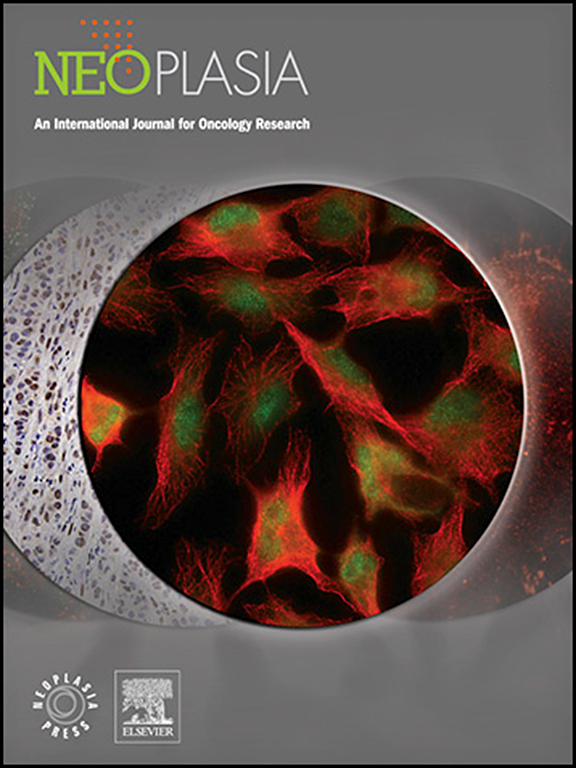Therapeutic benefit of the dual ALK/FAK inhibitor ESK440 in ALK-driven neuroblastoma
IF 4.8
2区 医学
Q1 Biochemistry, Genetics and Molecular Biology
引用次数: 0
Abstract
Neuroblastoma (NB) is a predominantly pediatric cancer with greater than 90% of cases arising in children under the age of five. More than half of patients have metastases detected at diagnosis, and high-risk disease is associated with five-year survival rates of only 50–60 %. Standard therapy involves highly toxic chemotherapy, surgery, radiation, and immunotherapy, and less toxic, more specific targeted therapies are urgently needed. Genomic studies have identified common driver aberrations in high-risk NB, such as MYCN amplification. In addition, a proportion of high-risk patients harbor amplification or activating mutations in anaplastic lymphoma kinase (ALK), and co-occurrence of ALK mutations and MYCN amplification have been associated with aggressive disease. In this study, we analyzed the efficacy of a Phase Ia-cleared, orally bioavailable dual ALK and focal adhesion kinase (FAK) inhibitor, ESK440, in multiple preclinical NB models. ESK440 potently inhibited proliferation of NB cell lines, with increased sensitivity in cell lines harboring ALK aberrations. ALK, FAK, and downstream target activation were rapidly decreased upon ESK440 treatment, and this was associated with impaired cellular migration and invasion. Importantly, ESK440 treatment also decreased MYCN levels. NB cell line and patient-derived xenograft studies showed significant reduction in tumor growth in ESK440-treated mice with no signs of toxicity. In certain NB models, ESK440 showed comparable or enhanced efficacy to lorlatinib, another clinical ALK inhibitor, and a lorlatinib-resistant cell line (COG-N-561 LR) retained sensitivity to ESK440. These preclinical results indicate that ESK440 is a promising targeted agent for ALK-driven NB and support future clinical studies to evaluate its efficacy in NB patients.
ALK/FAK双重抑制剂ESK440对ALK驱动的神经母细胞瘤的治疗效果
神经母细胞瘤(NB)主要是一种儿童癌症,90%以上的病例发生在五岁以下的儿童身上。一半以上的患者在确诊时已发现转移,高危疾病的五年生存率仅为 50%-60%。标准疗法包括高毒性化疗、手术、放疗和免疫疗法,目前急需毒性较低、更具特异性的靶向疗法。基因组研究发现了高危 NB 中常见的驱动基因畸变,如 MYCN 扩增。此外,一部分高危患者存在无性淋巴瘤激酶(ALK)扩增或激活突变,ALK突变和MYCN扩增的同时存在与侵袭性疾病有关。在这项研究中,我们在多个临床前 NB 模型中分析了一种 Ia 期通过的口服生物可用性 ALK 和局灶粘附激酶(FAK)双重抑制剂 ESK440 的疗效。ESK440 能有效抑制 NB 细胞系的增殖,对携带 ALK 畸变的细胞系的敏感性更高。ESK440治疗后,ALK、FAK和下游靶点活化迅速降低,这与细胞迁移和侵袭受损有关。重要的是,ESK440还能降低MYCN水平。NB细胞系和患者衍生异种移植研究显示,ESK440治疗小鼠的肿瘤生长显著减少,且无毒性迹象。在某些 NB 模型中,ESK440 显示出与另一种临床 ALK 抑制剂洛拉替尼(lorlatinib)相当或更强的疗效,而且洛拉替尼耐药细胞系(COG-N-561 LR)对 ESK440 仍保持敏感性。这些临床前研究结果表明,ESK440是一种治疗ALK驱动的NB的有前景的靶向药物,并支持未来评估其在NB患者中疗效的临床研究。
本文章由计算机程序翻译,如有差异,请以英文原文为准。
求助全文
约1分钟内获得全文
求助全文
来源期刊

Neoplasia
医学-肿瘤学
CiteScore
9.20
自引率
2.10%
发文量
82
审稿时长
26 days
期刊介绍:
Neoplasia publishes the results of novel investigations in all areas of oncology research. The title Neoplasia was chosen to convey the journal’s breadth, which encompasses the traditional disciplines of cancer research as well as emerging fields and interdisciplinary investigations. Neoplasia is interested in studies describing new molecular and genetic findings relating to the neoplastic phenotype and in laboratory and clinical studies demonstrating creative applications of advances in the basic sciences to risk assessment, prognostic indications, detection, diagnosis, and treatment. In addition to regular Research Reports, Neoplasia also publishes Reviews and Meeting Reports. Neoplasia is committed to ensuring a thorough, fair, and rapid review and publication schedule to further its mission of serving both the scientific and clinical communities by disseminating important data and ideas in cancer research.
 求助内容:
求助内容: 应助结果提醒方式:
应助结果提醒方式:


